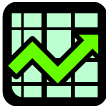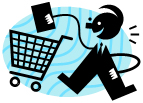The rhythmic cheering echoed up and down Pennsylvania Avenue today as Democrats took credit for a 3.2 percent increase in the gross domestic product (GDP) for the first quarter of 2010. Minutes after the benchmark number was announced, Speaker Nancy Pelosi issued a predictably feisty statement claiming credit for Democrats — and blaming Republicans as “obstructionists.” Later President Obama strode to the Rose Garden to proclaim that the GDP number had marked “an important milepost on the road to recovery."
Investors weren’t impressed, however. After all, the increase was below consensus expectations of 3.3 percent and a shadow of the robust 5.8 percent increase in the fourth quarter of 2009 (fueled in part by stimulus spending). And none was in the mood to celebrate when the buzz on the Street was all about a looming federal criminal fraud case against Goldman? The S&P 500 dropped 20, or 1.7 percent, ending April with a big loss.
So what’s really happening in the economy? If you step back from the mixed signals and market noise, there are clear signs of improvement — just not enough to supercharge the recovery or bring down the unemployment rate significantly any time soon. Consider the numbers:
 Economic Growth: Coming Back but Slowly
Economic Growth: Coming Back but Slowly
The good news is that the 3.2 percent rise in first quarter GDP marked the third straight quarterly increase in growth, and a sign that the recovery is taking hold. The bad news is that the rise was lower than expected, much slower than last quarter’s bounce-back off the bottom, and much, much slower than the 7.5 percent average growth rate for the nine months following the 1981-82 recession, the last slump to persist for more than a year. A 3.2 percent growth rate is respectable during the expansion phase of the economic cycle, but it’s weak for the recovery phase. To bring down unemployment just one percent would require a year of growth in the 5 percent range.
 Consumer Spending: Surprisingly Strong
Consumer Spending: Surprisingly Strong
After a lackluster 1.6 percent increase in consumer spending last quarter, consumer spending surged a stronger-than-expected 3.6 percent in the first quarter. That was the sharpest increase since 2007, when the recession began. Already feeling it at the cash register is Nadia Hassan, manager of Shoes by Lara in downtown Washington, D.C. “Right now we are doing very well,” she says as shoppers line up to buy Via Spiga, Nine West and other moderately priced footwear. “Before, for example, we got $300 to $400 a day, but now it’s like $1,000. It’s much better.” And it wasn’t just shoe sales that surged last quarter: increases were across the board from durables like home furnishings and household appliances, to discretionary purchases on recreational goods and vehicles, clothing and bars and restaurants. But will it continue? Experts say high unemployment, reluctance or inability to borrow, and sluggish income growth could restrain consumers’ willingness to step up spending going forward.
 Consumer Confidence: Mixed Signals
Consumer Confidence: Mixed Signals
Signals are mixed on consumer confidence. The Conference Board Consumer Confidence Index rose again in April to 57.9, the highest level in a year and a half. However, the survey found Americans are still wary about job and income growth, which will be key to future spending increases. While the percentage of consumers expecting a growth in jobs increased to 18.0 percent from 14.1 percent, those expecting increases in income dropped to 10.3 from 10.8 percent. Said Lynn Franco, Director of The Conference Board Consumer Research Center: “Looking ahead, continued job growth will be key in sustaining positive momentum."
 Housing: Glimmers of Recovery
Housing: Glimmers of Recovery
Spurred by the looming expiration of the homebuyers’ tax credit, new single-family housing sales jumped 26.9 percent in March versus February — the second highest monthly increase since Census records began, only exceeded by the gain in April 1963. Existing home sales also rose 6.8 percent, reversing a three-month decline. With housing affordability near all-time highs, mortgage rates still low and excess inventories declining, the worst may be behind us. Still, with bank lending restrained and the housing supply overhang still significant, most experts expect the recovery will be slow.
 Business: Opening Their Wallets
Business: Opening Their Wallets
After several quarters of strong earnings, it looks like corporate America is opening its wallet again. Business spending on new equipment rose at a 13 percent pace last quarter after rising at a 19 percent rate the previous three months, the biggest gain since 1998. “The clouds are breaking,” General Electric Co.’s Chief Executive Officer Jeffrey Immelt told shareholders in Houston this week. He believes business spending will actually lead the recovery going forward. As for GE, whose growth is being fueled by demand from emerging markets like China, Immelt says he plans to hire more workers in the U.S. this year.
 Employment: Glimmers of Hope
Employment: Glimmers of Hope
Payrolls jumped by 162,000 last month, the most in three years. Initial jobless claims are also showing improvement, dropping by 11,000 to 448,000 in the week ended April 24, the lowest level in a month. Meanwhile, unemployment has held at 9.7 percent for two months, down from a high of 10 percent. Other encouraging signs include a surge in temporary employment, which in the past has signaled hiring ahead. Since hiring was extremely restrained during the last expansion, some experts believe we could yet be surprised on the employment front. “This time we could have a job-full recovery,” says Lisa Emsbo-Mattingly, director of economic analysis for Fidelity Investments.
Of course, it will take much stronger growth to bring the unemployment rate down from 9.7 percent. If that happens, there will be real cause for jubilation.
Michelle Hirsch contributed additional reporting to this article.



